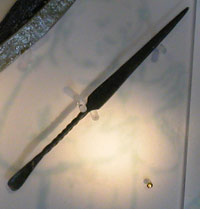 |
 |
 |
 |
 |
 |
 |
|
Fountains Abbey: History
Fountains Abbey: Buildings
|
Health care at Fountains (4/4)
The infirmary at Fountains, like that of other religious houses, was managed by the infirmarer (or server of the sick), who was a monastic official (obedientiary) of some prominence. He would have had at least one servant to assist him; a mid-fifteenth-century account book of Fountains records payments to a Thomas Perceval, who is described as a servant of the infirmary.(89) In addition to sick monks, the infirmarer would have cared for those recuperating from bloodletting, as well as older members of the community who required greater comfort and a more fortifying diet. Thomas Burton, one time abbot of Meaux Abbey, is thought to have retired to the infirmary at Fountains following his brief yet momentous abbacy; whilst here he compiled the first book of the chronicle of Meaux Chronicle. The twelfth-century customary of the Cistercian Order (Ecclesiastica Officia) discusses the infirmarer’s managerial duties in some detail, but says little of his medical knowledge. The infirmarer – and no doubt others in the abbey – was probably well-versed in herbal remedies and used herbs from the abbey’s herb garden. He would also have administered medicinal compounds, such as those recorded in the mid-fifteenth-century ‘Bursar’s Book’. This lists the abbey’s expenses from 1456 to 1459, including medicines purchased for the abbot and the community. These included a ‘pulvis vitalis’, a powder which was probably intended to promote vitality and strength, and a rather exotic powder against the pestilence [pulvis pestilenciea], which consisted of sanders wood, basil seeds, Armenian bole, cinnamon, dittany, gentian and tormentil roots, citron and sorrel seeds, pearls, sapphires and the bone of a stag’s heart. In 1457/8 the community bought this powder for the considerable sum of twelve shillings.(90) The ‘Bursar’s Book’ also lists purchases of pepper, ginger and liquorice, which were intended for medicinal purposes. The infirmarer would
also have had access to certain medical texts in the Fountains
library. An interesting example is a book given
to Abbot Huby in 1516 by William Peck, the vicar of Ripon College,
via
Thomas Kydd, a monk of Fountains. Much of the material in this
fourteenth-century copy relates to medical matters, chiefly the works
of Bernard de
Gordon, who was rector of the University of Montpellier, c.1285-1320.
It includes
his Lillium medicine, a seven-part work composed in 1303, and
a treatise on bloodletting, which describes when this treatment should
be suspended.
This work is now preserved in the British Library. Whilst most treatment of the
sick was probably dealt with by the community, lay medical practitioners
would have been summoned
to tend the seriously
ill. In 1448/9 a London physician, Henry Wells, was summoned to
Fountains Abbey to tend Abbot John
Greenwell, who, it was thought,
had been
poisoned by one of his monks. The accused, William Downom, was
said to have been prompted to this deed after the sick abbot refused
the pottage that he had diligently prepared.(91) Mid-fifteenth
century records
reveal that John Barbour of Ripon received a cow as a thank you
for curing one of the abbot’s coachmen, and that 7s 8d was
given to a doctor from Rievaulx and
his servant.(92) |
